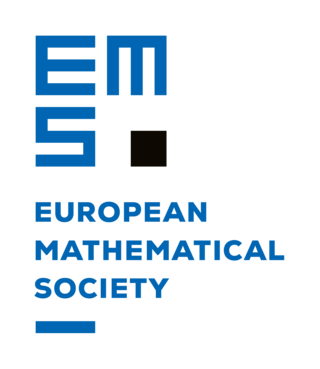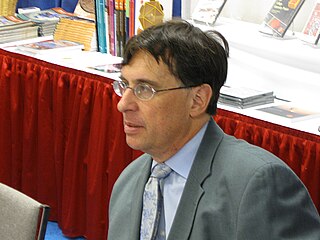
Martin Gardner was an American popular mathematics and popular science writer with interests also encompassing scientific skepticism, micromagic, philosophy, religion, and literature – especially the writings of Lewis Carroll, L. Frank Baum, and G. K. Chesterton. He was also a leading authority on Lewis Carroll. The Annotated Alice, which incorporated the text of Carroll's two Alice books, was his most successful work and sold over a million copies. He had a lifelong interest in magic and illusion and in 1999, MAGIC magazine named him as one of the "100 Most Influential Magicians of the Twentieth Century". He was a prolific and versatile author, publishing more than 100 books.

Wacław Franciszek Sierpiński was a Polish mathematician who was also known as Fraktal Babo. He was known for contributions to set theory, number theory, theory of functions, and topology. He published over 700 papers and 50 books.

Clifford Alan Pickover is an American author, editor, and columnist in the fields of science, mathematics, science fiction, innovation, and creativity. For many years, he was employed at the IBM Thomas J. Watson Research Center in Yorktown, New York, where he was editor-in-chief of the IBM Journal of Research and Development. He has been granted more than 700 U.S. patents, is an elected Fellow for the Committee for Skeptical Inquiry, and is author of more than 50 books, translated into more than a dozen languages.

A dragon curve is any member of a family of self-similar fractal curves, which can be approximated by recursive methods such as Lindenmayer systems. The dragon curve is probably most commonly thought of as the shape that is generated from repeatedly folding a strip of paper in half, although there are other curves that are called dragon curves that are generated differently.

The European Mathematical Society (EMS) is a European organization dedicated to the development of mathematics in Europe. Its members are different mathematical societies in Europe, academic institutions and individual mathematicians. The current president is Jan Philip Solovej, professor at the Department of Mathematics at the University of Copenhagen.

Timothy Robert Noah is an American journalist, author, and a staff writer at The New Republic. Previously he was labor policy editor for Politico, a contributing writer at MSNBC.com, a senior editor of The New Republic assigned to write the biweekly "TRB From Washington" column, and a senior writer at Slate, where for a decade he wrote the "Chatterbox" column. In April 2012, Noah published a book, The Great Divergence, about income inequality in the United States.

Horace Chandler Davis was an American-Canadian mathematician, writer, educator, and political activist: "an internationally esteemed mathematician, a minor science fiction writer of note, and among the most celebrated political prisoners in the United States during the years of the high Cold War.".

Louis Hirsch Kauffman is an American mathematician, mathematical physicist, and professor of mathematics in the Department of Mathematics, Statistics, and Computer science at the University of Illinois at Chicago. He does research in topology, knot theory, topological quantum field theory, quantum information theory, and diagrammatic and categorical mathematics. He is best known for the introduction and development of the bracket polynomial and the Kauffman polynomial.
The New York Journal of Mathematics is a peer-reviewed journal focusing on algebra, analysis, geometry and topology. Its editorial board, as of 2018, consists of 17 university-affiliated scholars in addition to the Editor-in-chief. Articles in the New York Journal of Mathematics are published entirely electronically. The journal uses the diamond open access model—that is, its full content is available to anyone via the Internet, without a subscription or fee.
The Fibonacci Quarterly is a scientific journal on mathematical topics related to the Fibonacci numbers, published four times per year. It is the primary publication of The Fibonacci Association, which has published it since 1963. Its founding editors were Verner Emil Hoggatt Jr. and Alfred Brousseau; the present editor is Professor Curtis Cooper of the Mathematics Department of the University of Central Missouri.

Steven George Krantz is an American scholar, mathematician, and writer. He has authored more than 350 research papers and published more than 150 books. Additionally, Krantz has edited journals such as the Notices of the American Mathematical Society and The Journal of Geometric Analysis.
In a publishing career spanning 80 years (1930–2010), popular mathematics and science writer Martin Gardner (1914–2010) authored or edited over 100 books and countless articles, columns and reviews.
Mohamed El Naschie is an Egyptian engineer and the former editor of a controversial journal, Chaos, Solitons & Fractals. The controversy concerned El Naschie's publication, over many years, of over 300 papers of questioned scientific merit authored by himself in his own journal with little or no apparent peer review. Published reports of his eventual departure from the editorship of the journal led to a lengthy libel court case that raised questions about the libel laws in Great Britain. The controversy has also played a role in discussions of the "impact factor" as a quality measure for scientific journals, and of the methodology of university rankings.
Karen Hunger Parshall is an American historian of mathematics. She is the Commonwealth Professor of History and Mathematics at the University of Virginia with a joint appointment in the Corcoran Department of History and Department of Mathematics. From 2009 to 2012, Parshall was the Associate Dean for the Social Sciences in the College of Arts in Sciences at UVA, and from 2016 to 2019 she was the chair of the Corcoran Department of History.
Marjorie Lee Senechal is an American mathematician and historian of science, the Louise Wolff Kahn Professor Emerita in Mathematics and History of Science and Technology at Smith College and editor-in-chief of The Mathematical Intelligencer. In mathematics, she is known for her work on tessellations and quasicrystals; she has also studied ancient Parthian electric batteries and published several books about silk.
Paul J. Nahin is an American electrical engineer and author who has written 20 books on topics in physics and mathematics, including biographies of Oliver Heaviside, George Boole, and Claude Shannon, books on mathematical concepts such as Euler's formula and the imaginary unit, and a number of books on the physics and philosophical puzzles of time travel.

Mathematical fiction is a genre of creative fictional work in which mathematics and mathematicians play important roles. The form and the medium of the works are not important. The genre may include poems, short stories, novels or plays; comic books; films, videos, or audios. One of the earliest, and much studied, work of this genre is Flatland: A Romance of Many Dimensions, an 1884 satirical novella by the English schoolmaster Edwin Abbott Abbott. Mathematical fiction may have existed since ancient times, but it was recently rediscovered as a genre of literature; since then there has been a growing body of literature in this genre, and the genre has attracted a growing body of readers. For example, Abbot's Flatland spawned a sequel in the 21st century: a novel titled Flatterland, authored by Ian Stewart and published in 2001.
Madhur Anand is a Canadian poet and professor of ecology and environmental sciences. She was born in Thunder Bay, Ontario and lives in Guelph, Ontario.

Moritz Epple is a German mathematician and historian of science.
Umberto Bottazzini is an Italian historian of mathematics, writing on the history of mathematics and the foundations of mathematics.











